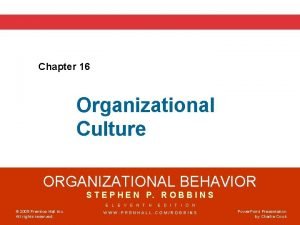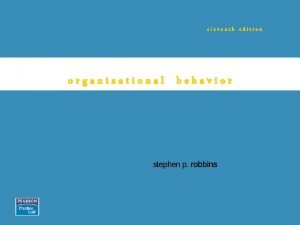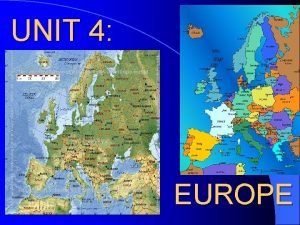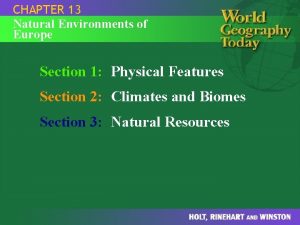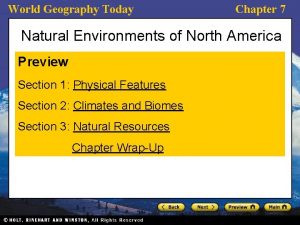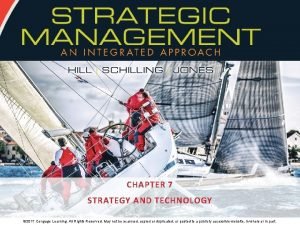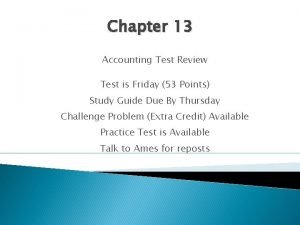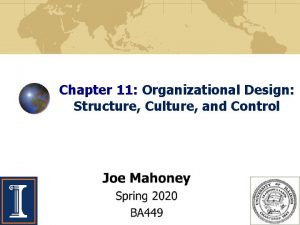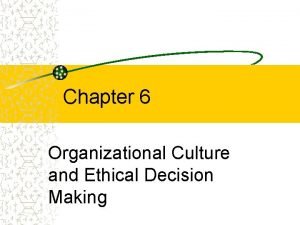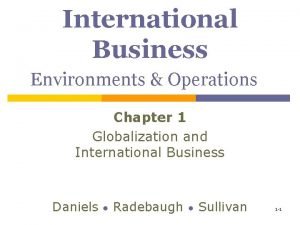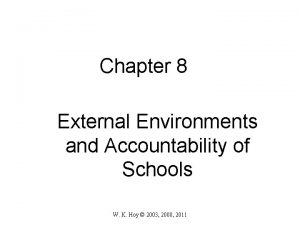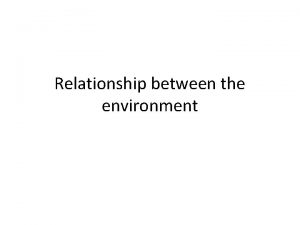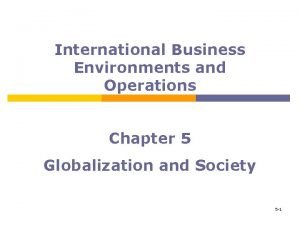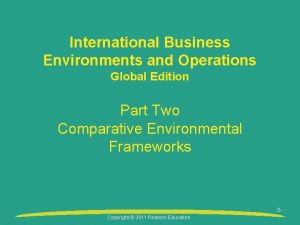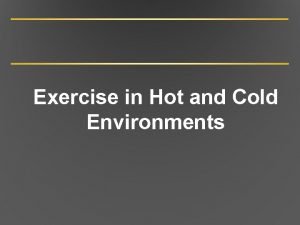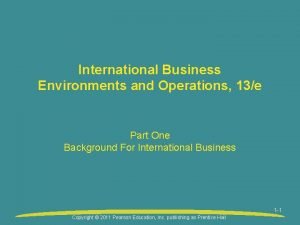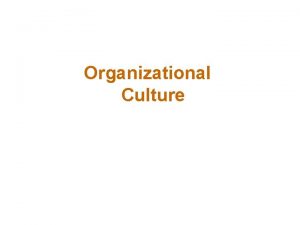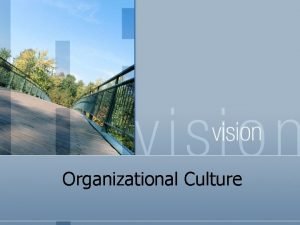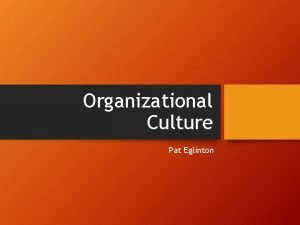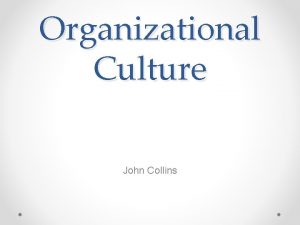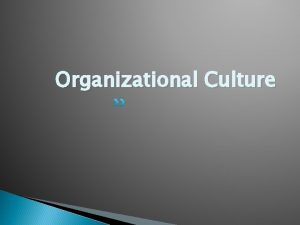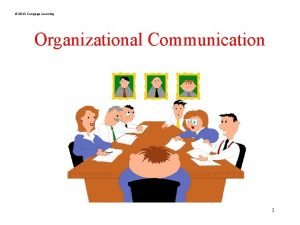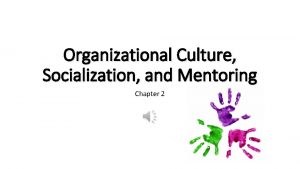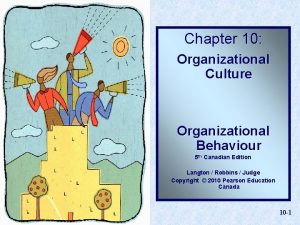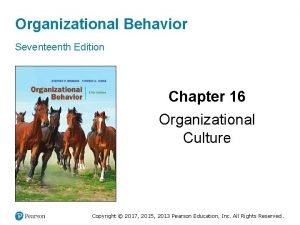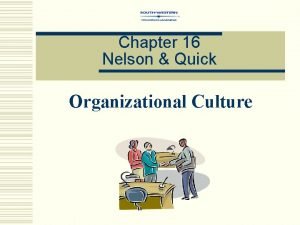Chapter 3 Organizational Environments and Culture 2015 Cengage































- Slides: 31

Chapter 3 Organizational Environments and Culture © 2015 Cengage Learning MGMT 7

3 -1 discuss how changing environments affect organizations 3 -2 describe the four components of the general environment 3 -3 explain the five components of the specific environment 3 -4 describe the process that companies use to make sense of their changing environments 3 -5 explain how organizational cultures are created and how they can help companies be successful © 2015 Cengage Learning

Characteristics of External Environments • Environmental change • Environmental complexity • Resource scarcity • Uncertainty 3 -1 © 2015 Cengage Learning

Environmental Change The rate at which a company’s general and specific environments change. • Stable – slow rate of change • Dynamic – fast rate of change © 2015 Cengage Learning 3 -1

Punctuated Equilibrium Theory Stability Dynamic Change Stability © 2015 Cengage Learning 3 -1

Environmental Complexity • Simple – few environmental factors that affect organizations • Complex – many environmental factors that affect organizations 3 -1 © 2015 Cengage Learning

Resource Scarcity The abundance or shortage of critical resources in an organization’s external environment. © 2015 Cengage Learning 3 -1

Uncertainty The extent to which managers can understand or predict the external changes and trends affecting their business. © 2015 Cengage Learning 3 -1

Environmental Change, Environmental Complexity, and Resource Scarcity © 2015 Cengage Learning 3 -1

General and Specific Environments © 2015 Cengage Learning 3 -2

Economy • A growing economy provides a favorable environment for business growth. • Business confidence indices show confident managers are about future business growth. 3 -2 © 2015 Cengage Learning

Technological Component • Technology – an umbrella term for the knowledge, tools, and techniques used to transform inputs into outputs Changes in technology can help companies provide better products or produce their products more efficiently. © 2015 Cengage Learning 3 -2

Sociocultural Component • Demographic characteristics, general behavior, attitudes, and beliefs of people in a particular society 3 -2 © 2015 Cengage Learning

Political/Legal Component • The legislation, regulations, and court decisions that govern and regulate business behavior • Many managers are unaware of the potential legal risks associated with traditional managerial decisions like recruiting, hiring, and firing employees. 3 -2 © 2015 Cengage Learning

Specific Environment • • • Customers Competitors Suppliers Industry regulations Advocacy groups © 2015 Cengage Learning 3 -3

Customer Component • Reactive customer monitoring – Identifying and addressing customer trends and problems after they occur • Proactive customer monitoring – Identifying and addressing customer needs, trends, and issues before they occur © 2015 Cengage Learning 3 -3

Competitor Component • Competitors – companies in the same industry that sell similar products or services • Competitive analysis – a process of monitoring the competition that involves identifying competition, anticipating their moves, and determining their strengths and weaknesses 3 -3 © 2015 Cengage Learning

Supplier Component • Suppliers – companies that provide material, human, financial, and informational resources to other companies Supplier dependence vs. Buyer dependence 3 -3 © 2015 Cengage Learning

Behaviors • Opportunistic behavior – when one party benefits at the expense of another • Relationship behavior – focuses on establishing a mutually beneficial, longterm relationship between buyers and sellers © 2015 Cengage Learning 3 -3

Industry Regulation Component Regulations and rules that govern the practices and procedures of specific industries, businesses, and professions 3 -3 © 2015 Cengage Learning

Federal Regulatory Agencies and Commissions • • • Consumer Product Safety Commission Department of Labor Environmental Protection Agency Equal Employment Opportunity Commission Federal Communications Commission Federal Reserve System Federal Trade Commission Food and Drug Administration National Labor Relations Board Occupational Safety and Health Administration Securities and Exchange Commission © 2015 Cengage Learning 3 -3

Advocacy Groups Concerned citizens who band together to try to influence the business practices of specific industries, businesses, and professions • Public communication • Media advocacy • Product boycott © 2015 Cengage Learning 3 -3

Making Sense of Changing Environments • Environmental scanning • Interpreting environmental factors • Acting on threats and opportunities © 2015 Cengage Learning 3 -4

Environmental Scanning Searching the environment for important events or issues that might affect an organization. • Managers scan the environment to reduce uncertainty. • Organizational strategies affect environmental scanning. • Environmental scanning contributes to organizational performance. 3 -4 © 2015 Cengage Learning

Interpreting Environmental Factors • Threat or opportunity? • Threat – managers typically take steps to protect the company from further harm • Opportunity – managers consider strategic alternatives for taking advantage of those events to improve performance © 2015 Cengage Learning 3 -4

Cognitive Maps © 2014 Cengage Learning © 2015 Cengage Learning 3 -4

Creation and Maintenance of Organizational Cultures • Primary source of organizational culture is the company founder. • Organizational culture is sustained by… – organizational stories – organizational heroes 3 -5 © 2015 Cengage Learning

Keys to an Organizational Culture © 2015 Cengage Learning 3 -5

Three Levels of Organizational Culture © 2015 Cengage Learning 3 -5

Changing Organizational Cultures • Behavioral addition • Behavioral substitution • Change visible artifacts • Hiring people with values and beliefs consistent with desired culture © 2015 Cengage Learning 3 -5

Camp Bow Wow 1. 2. 3. <click screenshot for video> What aspects of Camp Bow Wow’s corporate culture reflect the surface level of the organizational culture? What aspects reflect the values and beliefs? What aspects reflect the unconsciously held assumptions and beliefs. Why did Camp Bow Wow have to change its culture when it became a national franchise? What impact does Heidi Ganahl’s personal story have on employees at Camp Bow Wow? © 2015 Cengage Learning
 Chapter 16 organizational culture
Chapter 16 organizational culture How organizational culture form
How organizational culture form Chapter 13 natural environments of europe
Chapter 13 natural environments of europe Chapter 13 natural environments of europe
Chapter 13 natural environments of europe World geography
World geography Cengage learning chapter 7 answers
Cengage learning chapter 7 answers Cengage chapter 7
Cengage chapter 7 Chapter 13 medical math assignment sheet cengage learning
Chapter 13 medical math assignment sheet cengage learning Chapter 13 accounting
Chapter 13 accounting Copyright cengage learning. powered by cognero
Copyright cengage learning. powered by cognero Cengage learning heart diagram
Cengage learning heart diagram Cengage chapter 8 answers
Cengage chapter 8 answers Proximal medical term
Proximal medical term Matching muscle directions and positions
Matching muscle directions and positions Cengage medical terminology chapter 1
Cengage medical terminology chapter 1 Organizational design: structure, culture, and control
Organizational design: structure, culture, and control The role of corporate culture in ethical decision making
The role of corporate culture in ethical decision making International business: environments & operations
International business: environments & operations Internal and external environment of the school system
Internal and external environment of the school system Model-based agent example
Model-based agent example Micro market and macro environment
Micro market and macro environment International business chapter 5
International business chapter 5 International business environments and operations
International business environments and operations Exercise in hot and cold environments
Exercise in hot and cold environments International business environments and operations
International business environments and operations What is cultural divergence
What is cultural divergence Continuous culture and batch culture
Continuous culture and batch culture Difference between american culture and indian culture
Difference between american culture and indian culture Stab and stroke culture
Stab and stroke culture Folk culture and popular culture venn diagram
Folk culture and popular culture venn diagram Chapter 4 folk and popular culture
Chapter 4 folk and popular culture Urease test
Urease test
